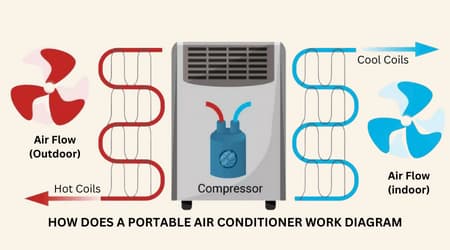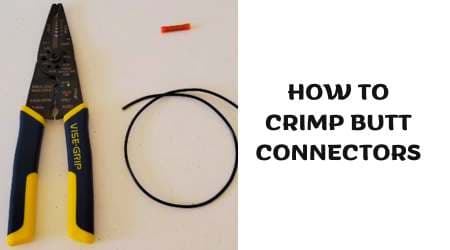Portable air conditioners work by drawing in warm air from the room, passing it over a set of evaporator coils to cool the air, and then blowing the cooled air back into the room. As the warm air passes over the coils, the refrigerant inside the coils absorbs the heat, transforming the gas into a cool liquid.
This process repeats until the desired temperature is reached. A portable air conditioner also removes excess moisture from the air, dehumidifying the room. These units are versatile, allowing for easy installation and movement from room to room, providing efficient and convenient cooling solutions.
With their compact and portable design, they offer a practical solution for cooling individual spaces without the need for permanent installation or ductwork.
How a portable air conditioner works
Portable air conditioners are becoming increasingly popular as a convenient and energy-efficient way to cool indoor spaces. Understanding how these portable cooling devices work can help you make an informed decision when choosing the right one for your needs. We'll explore the basics of how portable air conditioners work, including the components that make them function, the refrigeration cycle they employ, and the crucial role of refrigerant in the cooling process.
Components Of A Portable Air Conditioner:
- Compressor: Compressor is the most important component of the portable air conditioner. It is the one that is responsible for compressing the refrigerant. It converts the gas into liquid. It is the one that makes the air conditioner working.
- Condenser: Second important component of the portable air conditioner is Condenser. Hot refrigerant gas passes through the condenser, where it releases heat to the surroundings and transforms into a high-pressure liquid.
- Evaporator: High-pressure liquid refrigerant enters the evaporator, where it rapidly evaporates, absorbing heat from the room air.
- Fan: The evaporator fan circulates warm air from the room over the cold evaporator coil, cooling the air in the process. The cooled air is then blown back into the room.
- Exhaust hose: To expel the hot air generated during the cooling process, the portable air conditioner uses an exhaust hose that is vented through a window or another opening in the room.
Refrigeration Cycle:
- Step 1: Compressor compresses the low-pressure refrigerant gas, raising its temperature and pressure.
- Step 2: The hot refrigerant gas flows through the condenser, releasing heat to the surrounding air and changing into a high-pressure liquid.
- Step 3: High-pressure liquid refrigerant enters the expansion valve or capillary tube, which restricts its flow, reducing its pressure.
- Step 4: As a result of the pressure drop, the refrigerant evaporates into a low-pressure gas in the evaporator, absorbing heat from the room air.
- Step 5: Evaporator fan blows air over the cold evaporator coil, cooling it down and circulating the cooled air back into the room.
- Step 6: Low-pressure gas refrigerant then travels back to the compressor, and the cycle repeats.
How Refrigerant Plays A Key Role In Cooling:
- Refrigerant: This fluid circulates through the components of the portable air conditioner, undergoing phase transitions that enable the transfer of heat from the indoor air to the outside.
- Cooling process: The refrigerant absorbs heat from the room air in the evaporator, causing it to evaporate and turn into a low-pressure gas. This heat transfer cools the air circulating in the room.
- Heat dissipation: The hot refrigerant gas passes through the condenser, releasing the absorbed heat to the outside air. It then condenses back into a liquid to continue the cycle.
Understanding the basics of how portable air conditioners work can help you better appreciate their functionality. The components, refrigeration cycle, and role of refrigerant all combine to create an efficient and effective cooling process for you.
How does a portable air conditioner work diagram

How portable air conditioner works to cool down a room

Benefits And Limitations Of Portable Air Conditioner
Benefits and limitations of a portable air conditioner helps in making informed decisions for comfort and convenience. As with any home appliance, each type comes with its pros and cons.
Benefits
Advantages of owning a portable air conditioner are significant. They include:
- Easy Installation: Portable AC units don't need complicated setup. Plug them in and vent out a window.
- Flexibility: Move the unit to different rooms as needed. It's cooling on wheels.
- Space-saving: Compact designs save floor space, ideal for smaller rooms or apartments.
- Energy Efficiency: Choose a model with a good energy rating to save on electricity bills.
- No Permanent Changes: Perfect for renters, no need to alter the window structure.
Limitations
While portable air conditioners are handy, they have drawbacks:
- Noisy Operation: They can be louder than built-in units.
- Water Management: Some require frequent draining of collected moisture.
- Limited Cooling Area: They are most effective in smaller spaces.
- Window Access Needed: Venting out a window is necessary, limiting placement.
- Heavy and Bulky: While movable, they can be cumbersome to transport up and down stairs.
Maintenance Of Portable Air Conditioner
Maintaining a portable air conditioner ensures longevity and efficiency. Simple steps can keep it running smoothly. Here are essential maintenance tips.
Cleaning The Filter
Dust and dirt can block airflow, making the unit work harder. Filters need regular checks. Most units have washable filters. Follow these steps:
- Turn off and unplug the air conditioner.
- Remove the filter according to the manual.
- Use warm water and gentle soap to clean it.
- Rinse thoroughly and let it dry completely.
- Replace the filter in the unit.
Clean filters monthly for optimal performance.
Emptying The Water Tank
Portable air conditioners dehumidify air and collect water. Tanks must be emptied regularly to prevent overflow and bacteria.
- Switch off and unplug the device.
- Find the water tank, usually at the bottom.
- Detach and empty the tank over a sink or outdoors.
- Clean the tank with a disinfectant.
- Reattach and secure the tank before restarting.
Check water levels frequently during humid conditions.
Storage
Proper storage prolongs air conditioner life. Clean and dry before storing. Avoid damp locations. Cover the unit to prevent dust buildup.
| Step | Action |
|---|---|
| 1 | Clean the air conditioner as per instructions. |
| 2 | Drain any remaining water from the tank. |
| 3 | Allow the unit to dry thoroughly. |
| 4 | Wrap in a protective cover or store in the original box. |
| 5 | Place in a cool, dry space away from direct sunlight. |
Check the unit periodically during storage for any issues.
Frequently Asked Questions Of How Do Portable Air Conditioner Works
Do All Portable Air Conditioners Have To Be Vented Out A Window?
Most portable air conditioners require venting through a window to expel hot air. Some models, known as ‘ventless' or ‘evaporative' coolers, don't require window venting.
Do All Portable Air Conditioners Need To Be Drained?
Not all portable air conditioners require draining. Some models include self-evaporative systems that expel most moisture through the exhaust hose, minimizing the need for manual draining. However, in very humid conditions, occasional draining may be necessary.
How Long Does It Take For A Portable Air Conditioner To Cool A Room?
A portable air conditioner typically cools a room within 20 minutes to 2 hours, depending on the room size and unit capacity.
Do Portable Air Conditioners Need To Be Plugged In?
Yes, portable air conditioners require plugging into a power outlet to operate effectively.
Conclusion
Purchasing a portable air conditioner is a great way to stay cool in the summer. A portable air conditioner is a great way to cool an entire room or a few people. They are portable, easy to use, and convenient. You can buy them at most stores and you can even purchase them online. If you are interested in purchasing a portable air conditioner, you can consider these Best Portable Air Conditioner & Heater.






Comments are closed.